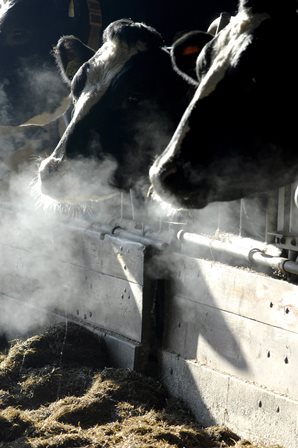 Large-scale methane measurements on individual ruminants for genetic evaluations
Large-scale methane measurements on individual ruminants for genetic evaluations
Genetic possibilities to reduce enteric methane emissions from ruminants
Natalie Pickering (New Zealand) and Yvette de Haas (The Netherlands) were invited to write a review on the genetic possibilities to reduce enteric methane emissions from ruminants. This review is now published in Animal.Methane emission
Methane (CH4) is a greenhouse gas (GHG) that contributes to climate change. The livestock sector, particularly ruminants, is estimated to contribute up to 18% of total global anthropogenic GHG emissions. The rumen is the major site of methane production in which anaerobic archaeal microorganisms convert H2 and CO2 to CH4. In ruminants, methane is a natural by-product of anaerobic respiration, produced predominantly in the rumen (~90%), and to a small extent in the large intestine (~10%).
Solutions for reduction
Technical solutions to reduce enteric methane emissions have been, and continue to be, extensively researched. Animal breeding that exploits existing animal variation in methane emissions is an additional mitigation strategy that is cost-effective, permanent, and cumulative. From this review it has been observed that both methane emissions (g/day) are a heritable and repeatable trait. Methane emissions are strongly related to feed intake both in the short term (minutes to several hours) and over the medium term (days). When measured over the medium term, methane yield (MY, g CH4/kg dry matter intake) is a heritable and repeatable trait albeit with less genetic variation than for methane emissions.
Measuring methane
The current ‘gold standard’ for measuring methane emissions is respiration chambers, but these are expensive and impractical for large-scale data collection. The sulphur hexafluoride (SF6) technique can be used for field-scale data collection, but requires insertion of rumen boluses, daily animal handling and laboratory measurement of gases. In recent years, researchers have developed many innovative non-invasive techniques, either by infrared or photo acoustic gas analysers, or by using a laser methane detector. The review shows that these short term (over minutes to hours) measurements of methane emissions show promise, especially on systems where animals are fed ad libitum and frequency of meals is high. However, we believe that for short term measurements to be useful for genetic evaluation, a number (between 3 and 20) of measurements will be required over an extended period of time (weeks to months). This opens up the opportunity to have a large scale recording of individual methane emissions, and therefore start breeding for lower emitting animals as animal breeding strategies require measurements on a large population of animals.
Breeding for reduced emissions
With the recent successful incorporation of genomic information into breeding schemes the reliance on very large populations of phenotyped animals is somewhat relaxed. However, a reference population of several thousand animals is still required to estimate the contribution of each genomic region to expression of the phenotype under investigation. This includes the need for combined resources across countries in an international effort, emphasising the need to acknowledge the impact of animal and production systems on measurement of the methane trait during design of experiments.
Read the (open access) paper on: http://dx.doi.org/10.1017/S1751731115000968
Contact Yvette.deHaas@wur.nl for more information.



